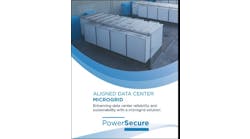What’s the key to unlocking the commercial and industrial market? Repeatable and turnkey microgrids, says Lisa Laughner, president and CEO, Go Electric, a microgrid provider.
Most microgrids today are custom designed, which can be expensive. Standardization drives down cost.
“In order for commercial and industrial customers to readily adopt microgrids, we need to make them turnkey and scalable. We can’t do unique designs; it drives up costs and takes too long,” she says.
Go Electric is working toward installing a microgrid system in a day, she says. Go Electric’s system takes battery storage, adds microgrid controls and uninterruptible power on top, establishing a central “hub” that DERs are connected to. Renewables can also be part of the system.
“We can do that over and over whether it’s a bank branch in California or Texas. We’re making it repeatable and scalable, instead of a different microgrid for every building,” Laughner says.
Go Electric’s system connects all of a company’s generators. Go Electric uses “optimization algorithms” that help decide how to efficiently dispatch generating units, renewables and energy storage.
Instead of firing up a whole new generator, the company can use batteries to help with load fluctuations, she adds.
Key to creating these repeatable and turnkey microgrids is sizing them to handle a company’s entire load and participating in demand-response programs, Laughner says. While it’s more expensive to size them to meet an entire load — as opposed to critical loads — the extra electricity can generate income through demand-response programs.
Join us at Microgrid 2018 and gain valuable market insight from Lisa Laughner and other microgrid industry CEOs.
“Rather than trying to figure out the critical loads versus the non-critical loads, and design load panels so the microgrid only carries critical loads, you can economically make it larger and provide demand response,” she says.
When the company makes this simple design decision, design and installation costs drop due to the fact that there’s a less complex design configuration and customers don’t have to identify which loads are critical.
Turnkey microgrids & wholesale demand response
“You lower your costs, customers are happier, you have a bigger system and can serve all the loads instead of some. If you are in a demand response program with the utility, you can shed more load and it pays for itself really well,” she explains.
Companies can enroll in wholesale demand response programs in nearly every state, including the California ISO, PJM, the New York ISO and ERCOT. The largest retail demand-response programs are in California, Hawaii and New York, she adds.
“Not everyone offers retail, but you can get your system enrolled in wholesale demand-response in pretty much every state,” she says.
Under the wholesale demand-response programs, the ISO, for example, sells wholesale power to the retail utilities, and prices rise and fall depending on supply and demand. They’ll pay customers to shed load during peak periods.
“You can enroll your asset and promise to use that energy asset to shed loads. You can do that with batteries or generators. If you can island away from the grid and feed your load with renewables, you can do this with renewables,” she adds.
Meet Lisa Laughner, president and CEO, Go Electric, at Microgrid 2018
Go Electric has about 13 projects in various stage of development. About six of them involve renewables, Laughner notes. Three of the projects are military microgrids and three are commercial or industrial facilities in Hawaii.
The company is also developing mobile microgrid technology for the Army for use on foreign bases.
“Typically at a base, there are lots of tents with a generator providing power for lights and air conditioning inside the tent. They all tend to be inefficient, but if you tie them together with our system, they run much better,” she explains. By typing together the generators and optimizing their operation, Go Electric can cut fuel consumption by about 80 percent, she says.
Go Electric is a startup that’s developing a system with energy storage, a patented microgrid controller and software. The system integrates renewable energy and provides secure power and peak shaving to facilities, plus grid stabilizing services to utilities. Go Electric has won $9 million in contracts, according to company information.
What are the advantages of custom versus turnkey microgrids? Comment below or on our LinkedIn Group, Microgrid Knowledge.








